I received the TM28 from Nitecore for the Review.
The TM28 is a Search and rescue light, running 4 XH-P 35 HI LEDs powered 4 18650 batteries. The light features a double stage electronic switch that controls the LEDs, and a digital display controlled by a separate single stage electronic switch. On the display several useful information appears, like the level and output, the runtime left, internal temperature and battery voltage. The TM28 features an integrated charging system for the 4 18650 batteries.
The TM28 comes in this big and heavy box.
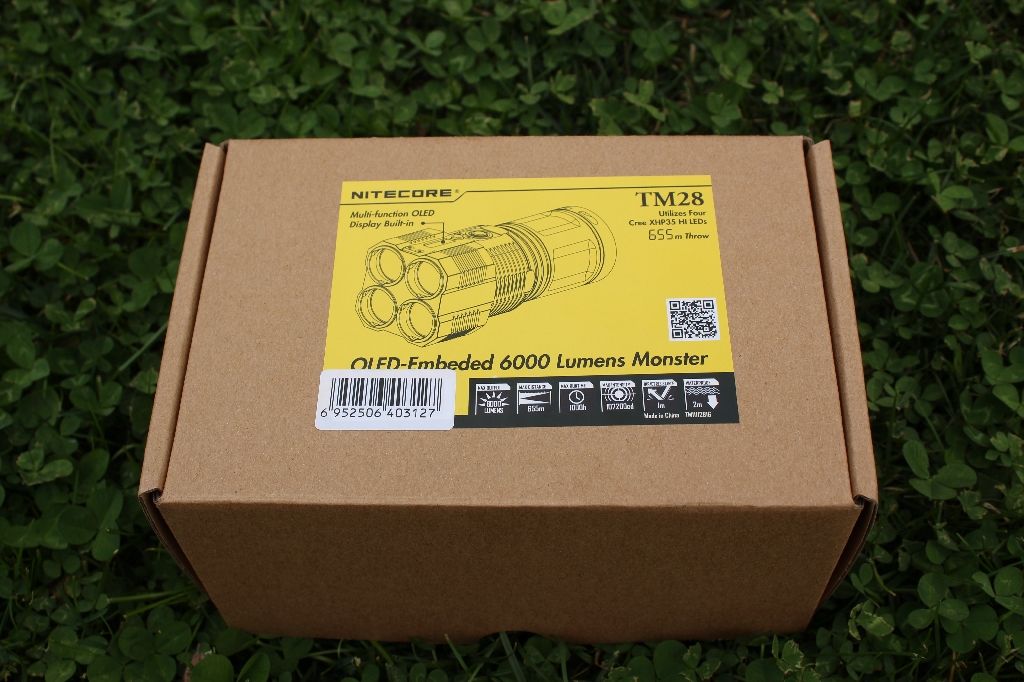
Some disclaimers
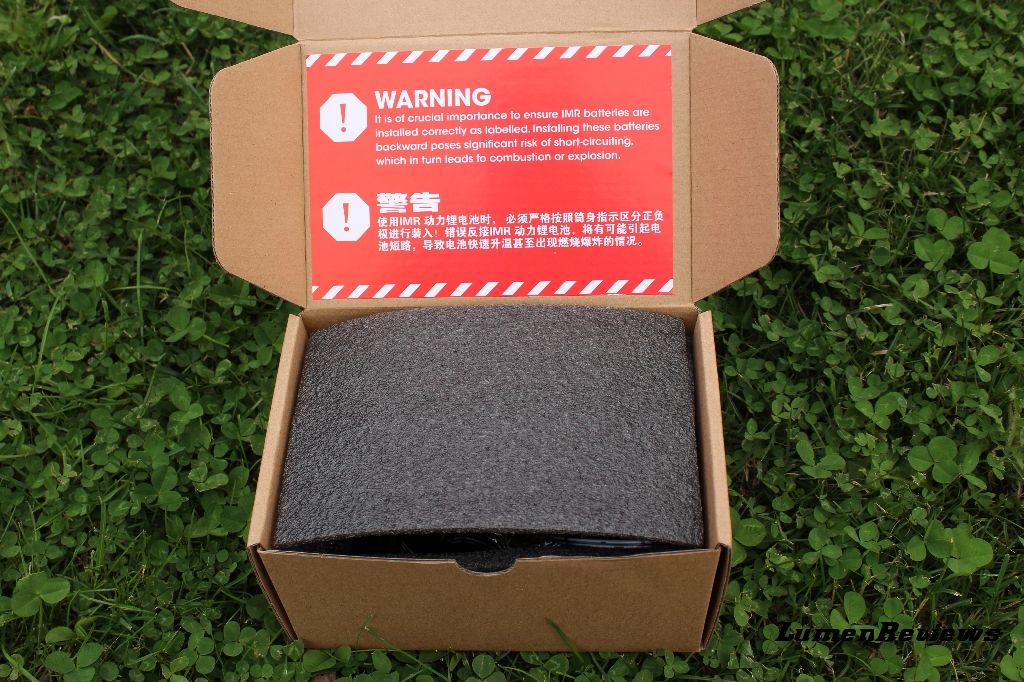

The light (comes in the sheath) with the batteries inside, manual, spare o-rings, adapter for using flat top 18650 and charging cable (EU plug in my sample).
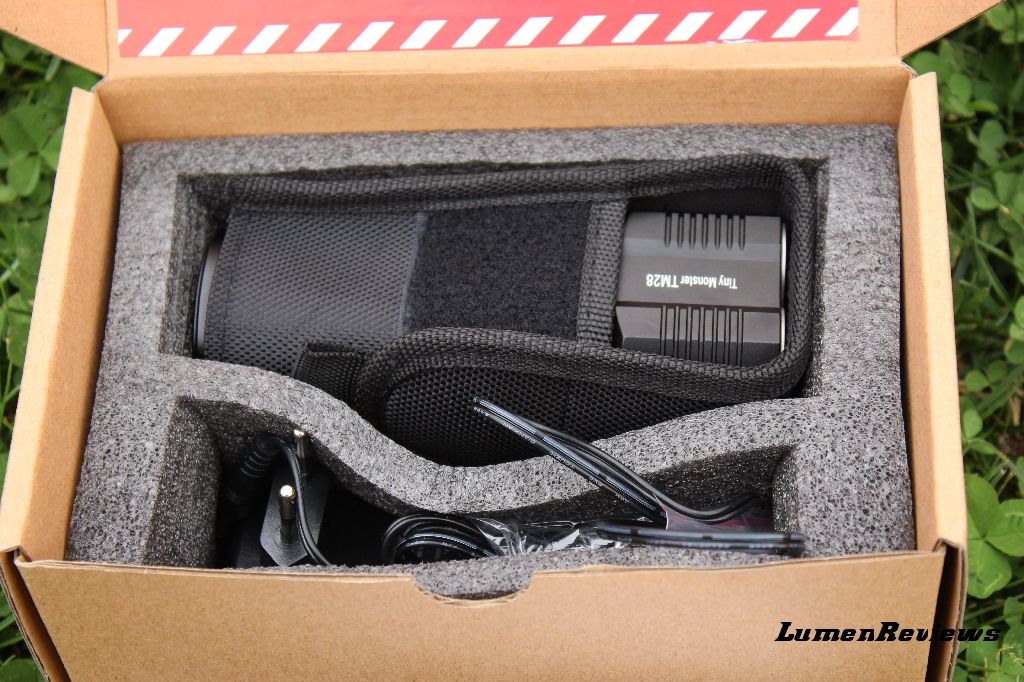
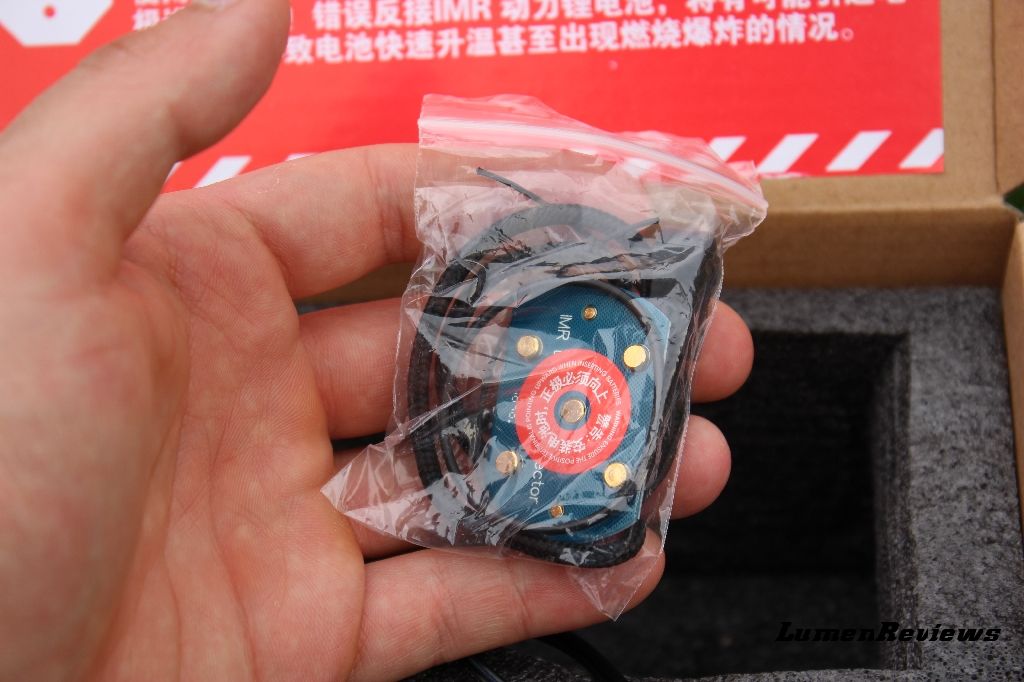
My sample came with 4 18650 Nitecore 3100mAh IMR battery with PCB that allow current flow up to 10A.
The TM28 has a circular body with a big squared head, which is recognizable even when the light is in the sheath
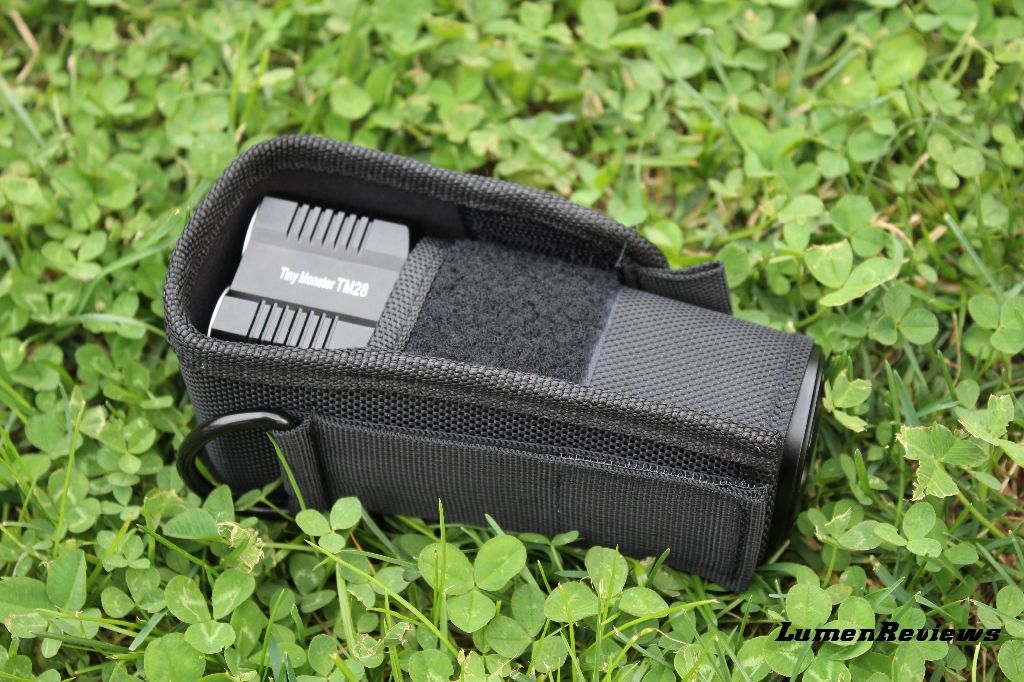
The light has an interesting look. I like the contrast generated by the sanded bezels, the smooth reflectors and the purple reflection on the glass.
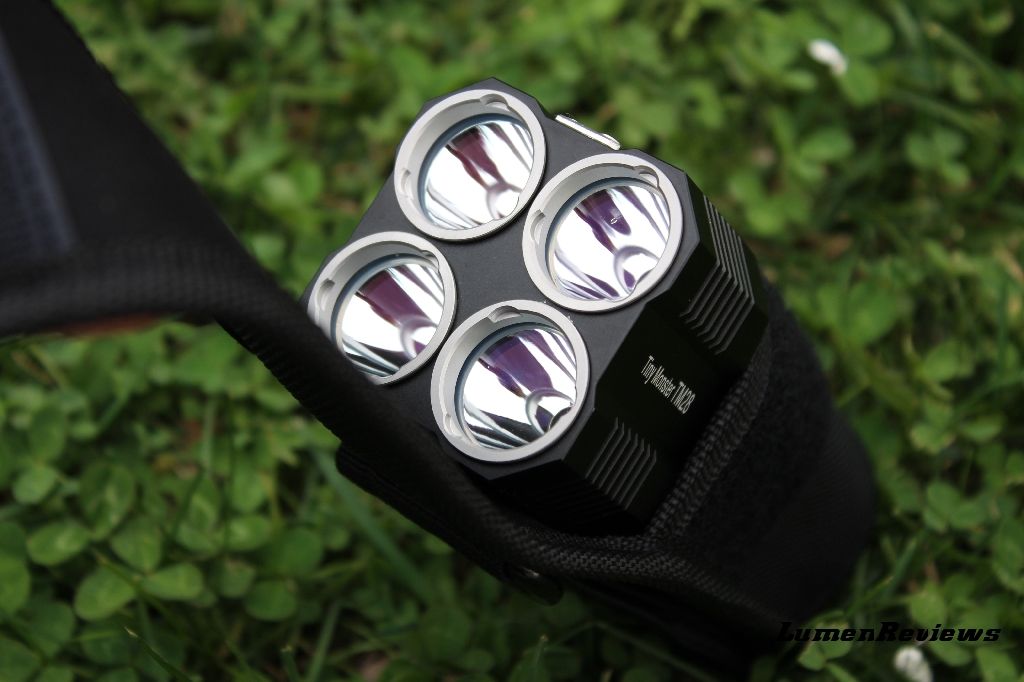
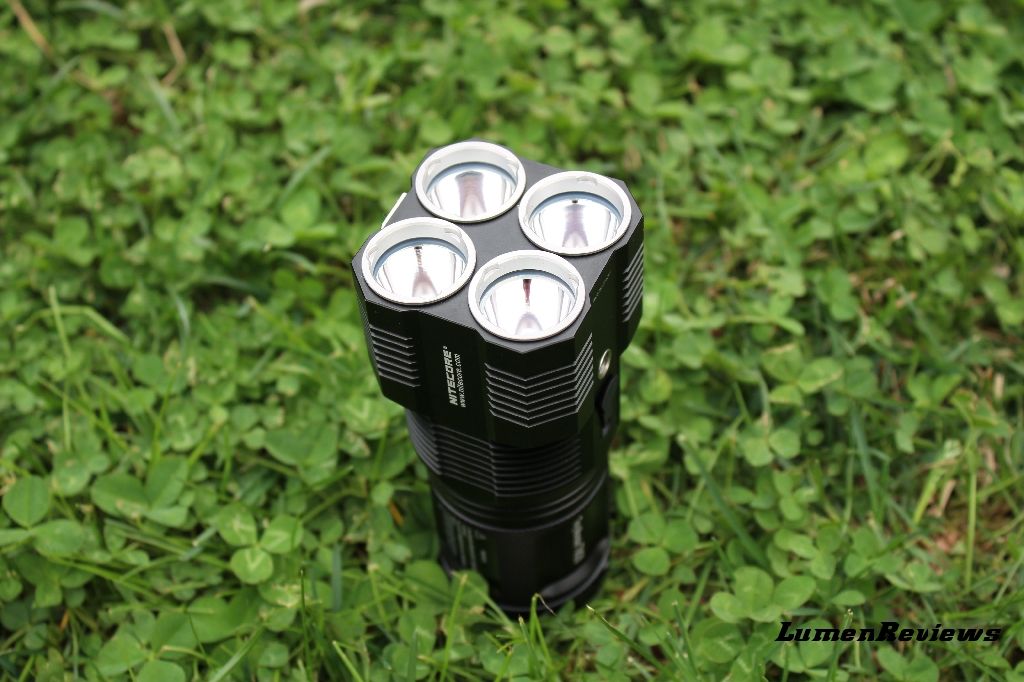
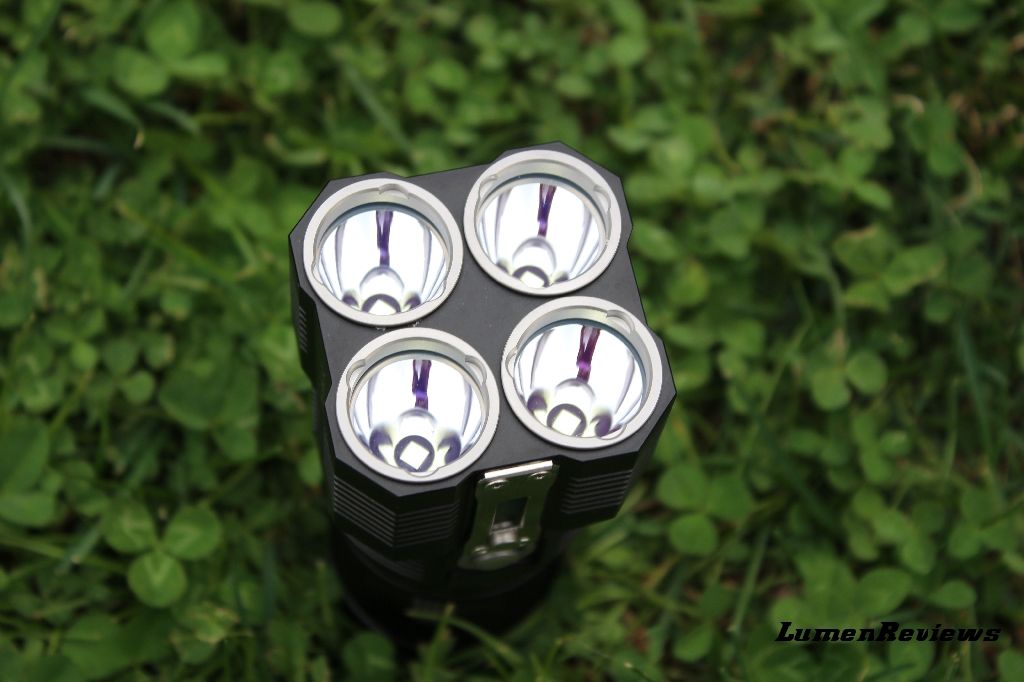
The body is kind of short and the head rather heavy, but when the 4 18650 are inside, the light is well balanced in the hand.
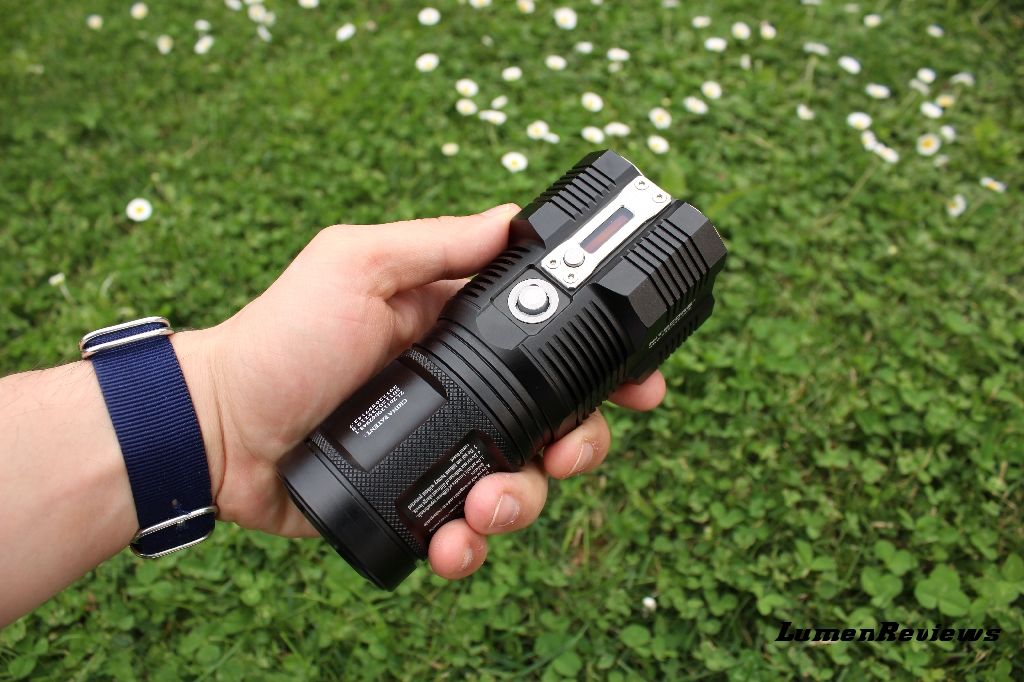

Moving between the switches is easy


Some detail of the light
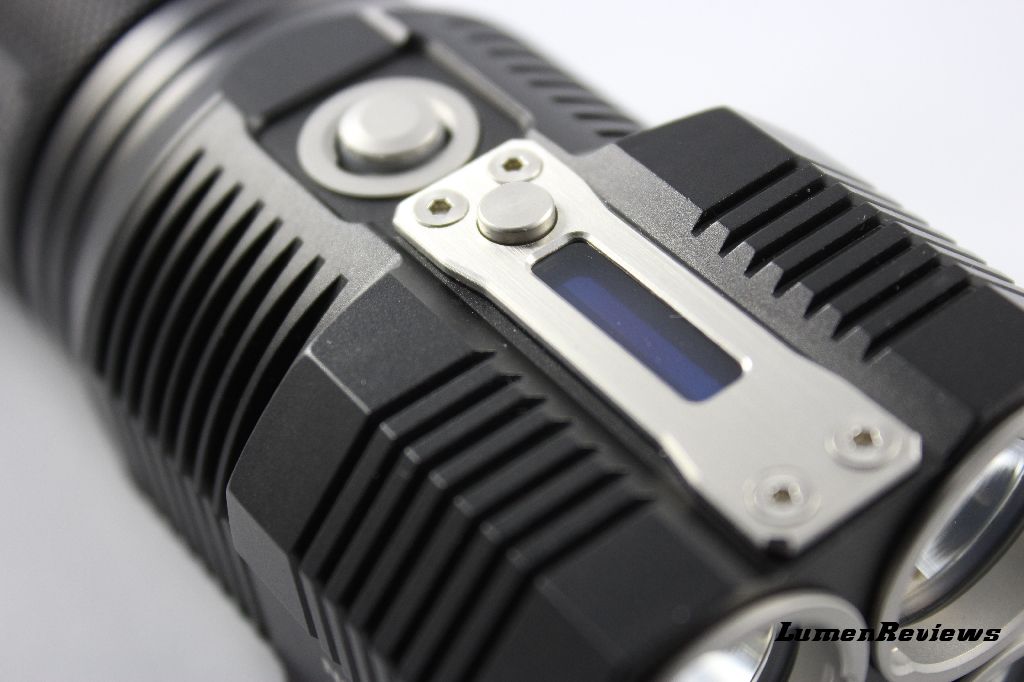
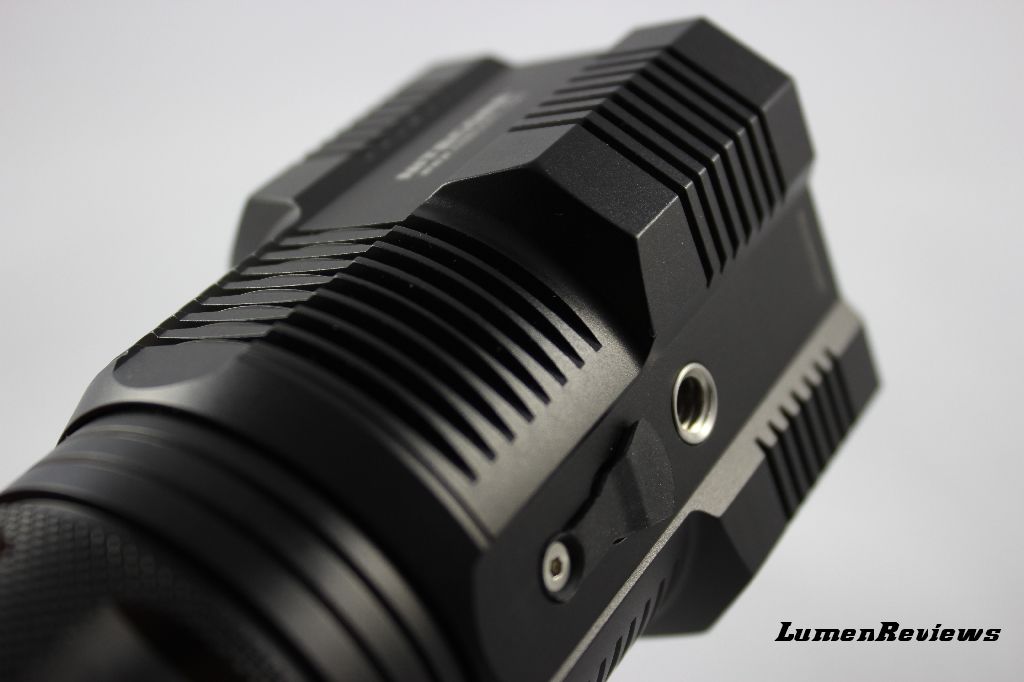
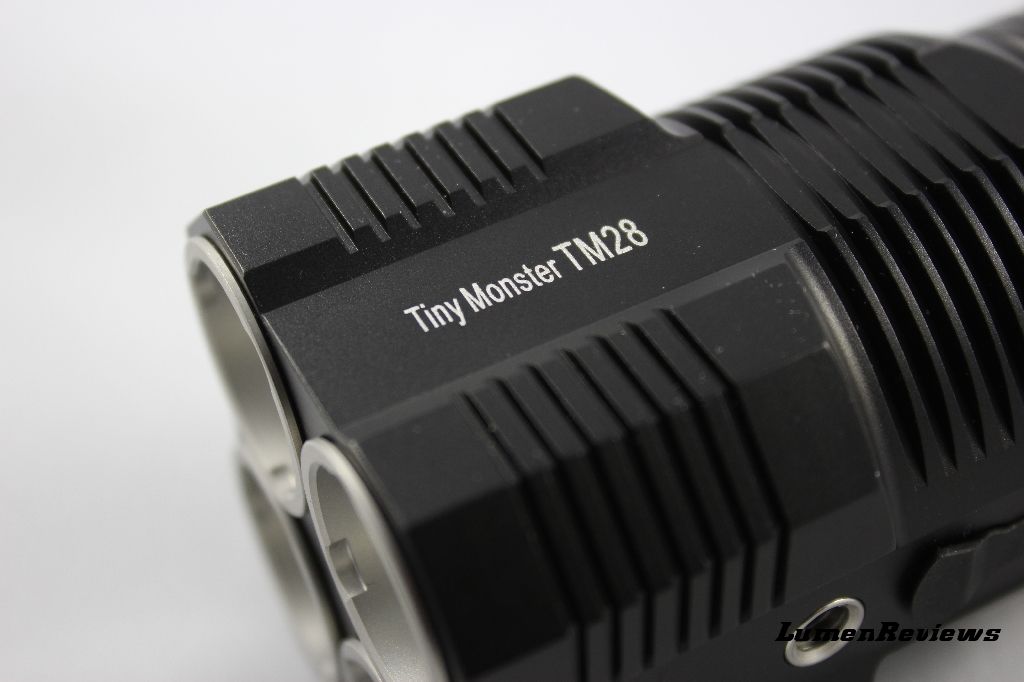
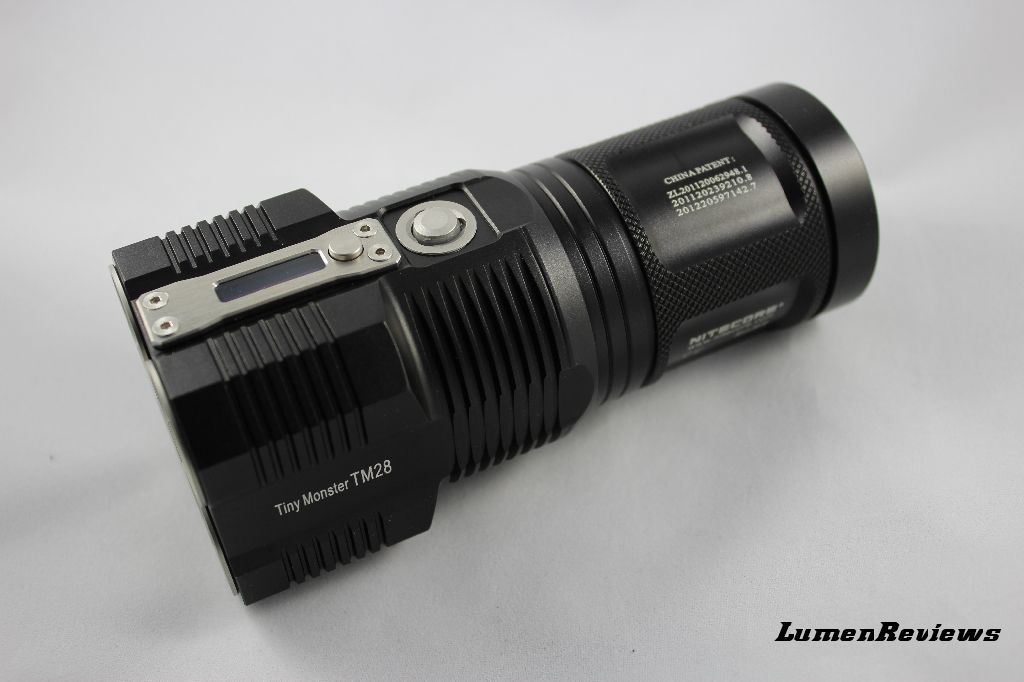
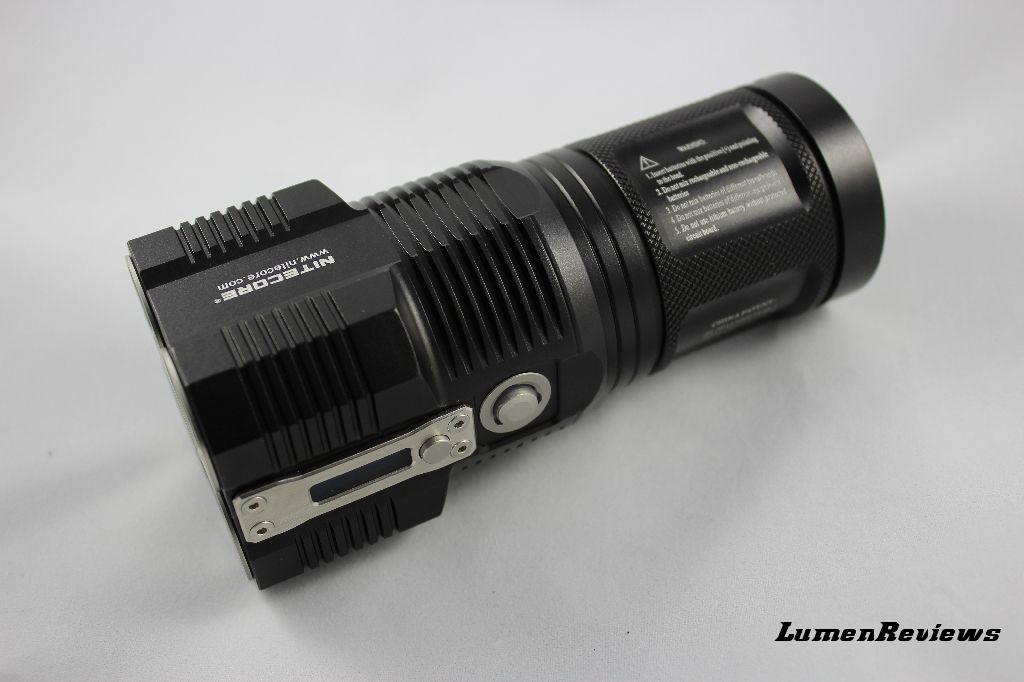
On one side, there is both the charging plug and the tripod screw.
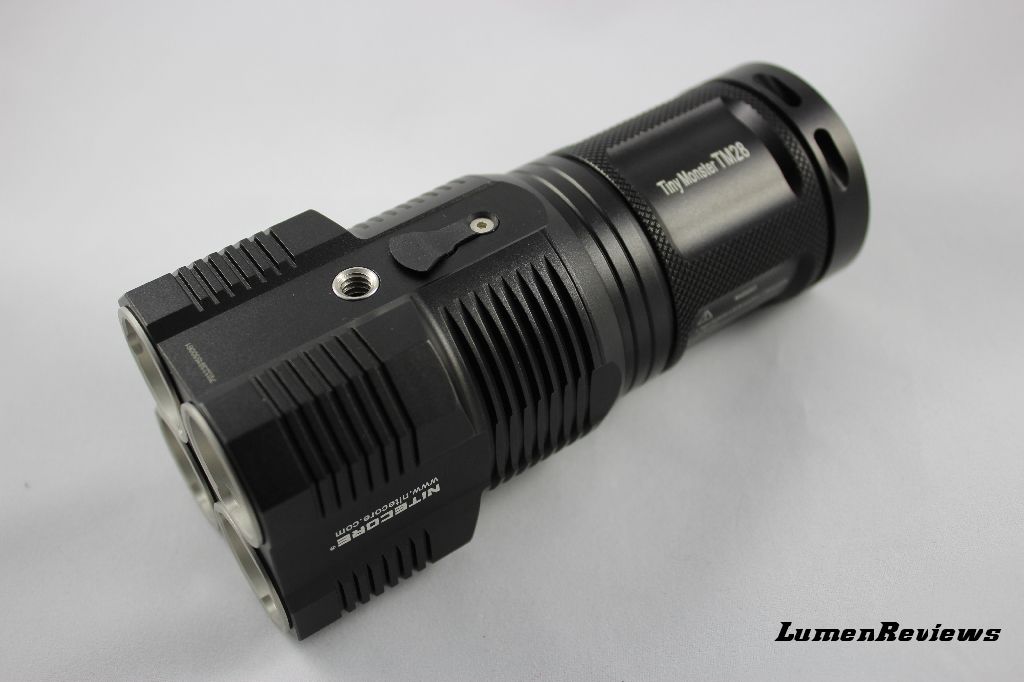
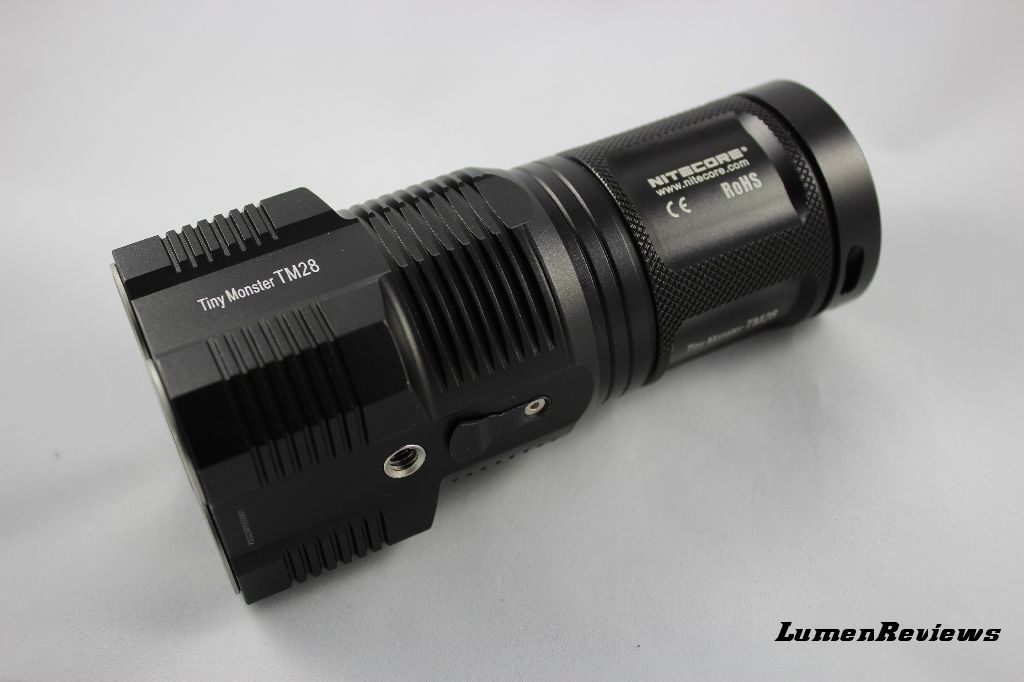
The charging port is covered by a rubber cover that stays solidly in position
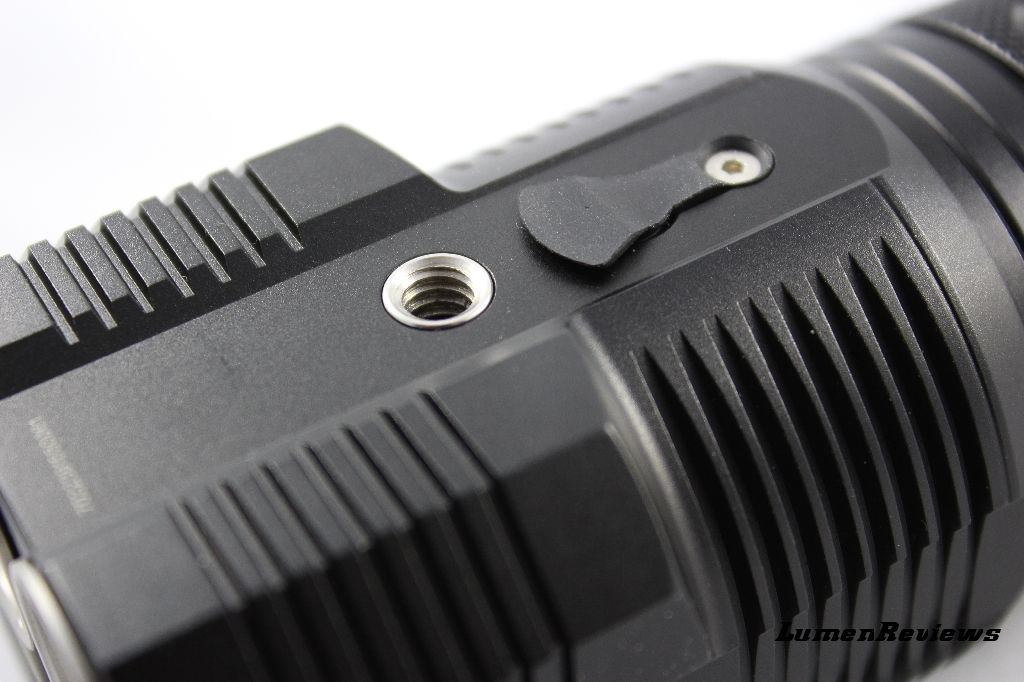
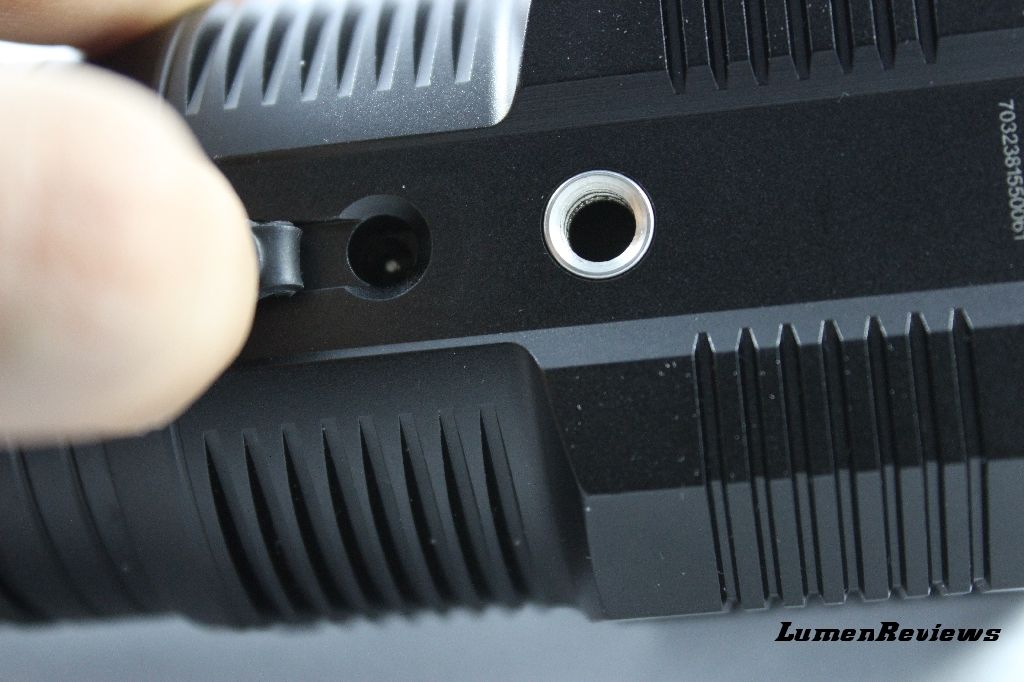
Tailcap is flat and allows tailstand. It is glued in position and cannot be taken off with hands. It has a lanyard hole.

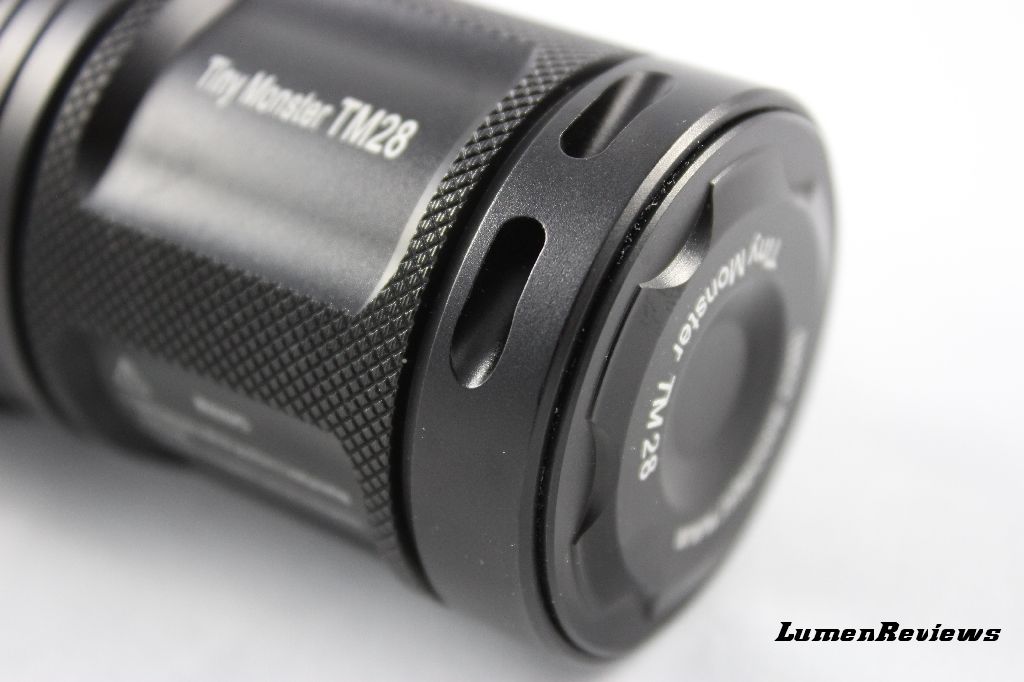
Every one of the four XHP-35 Hi emitter is in a smooth separated smooth reflector, quite deep, and with an AR treated glass on top of each.
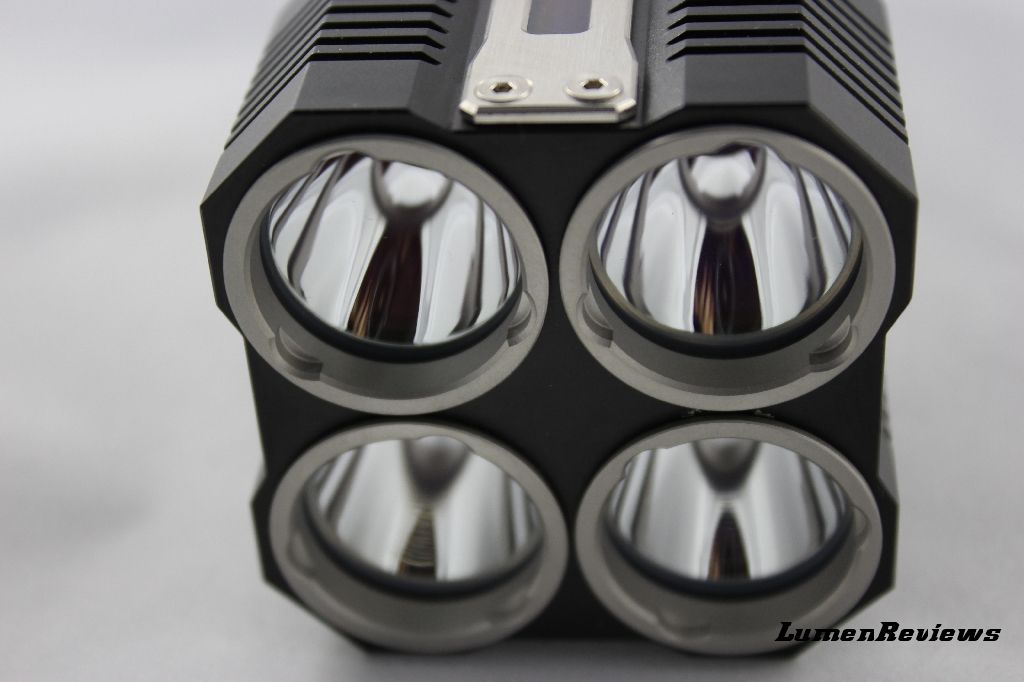
The light is compact (142 x 57 mm), a bit more than 2 18650 cells. The four batteries I received with the light
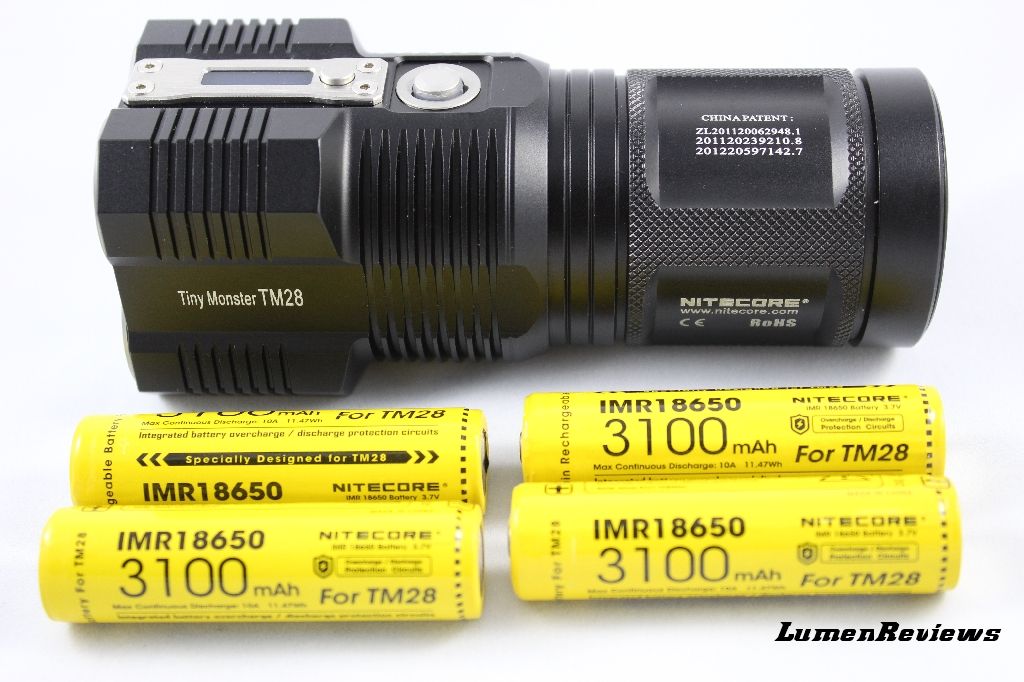

On the batteries the labels says: Designed for TM28
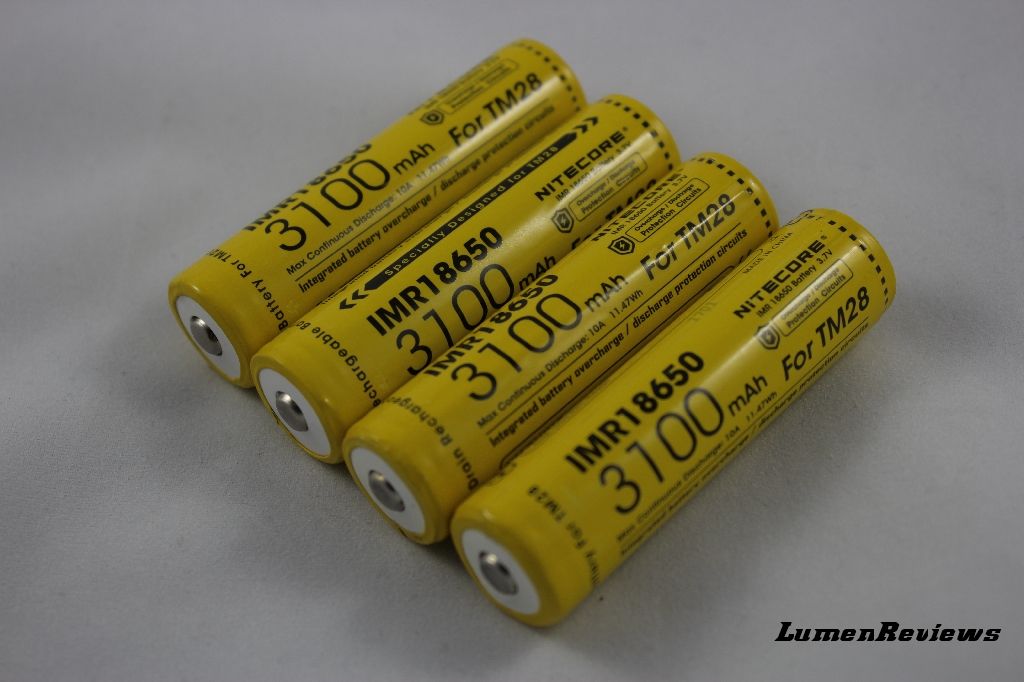
Taking the light apart

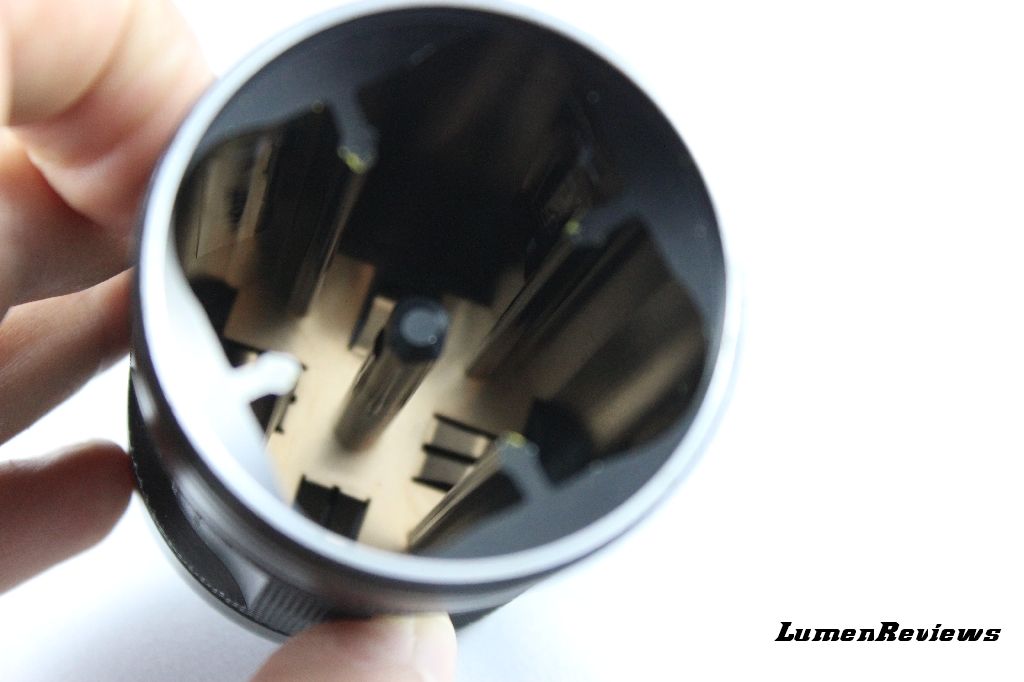

Well made, anodized (physical lockout is possible) and lubed threads from the factory
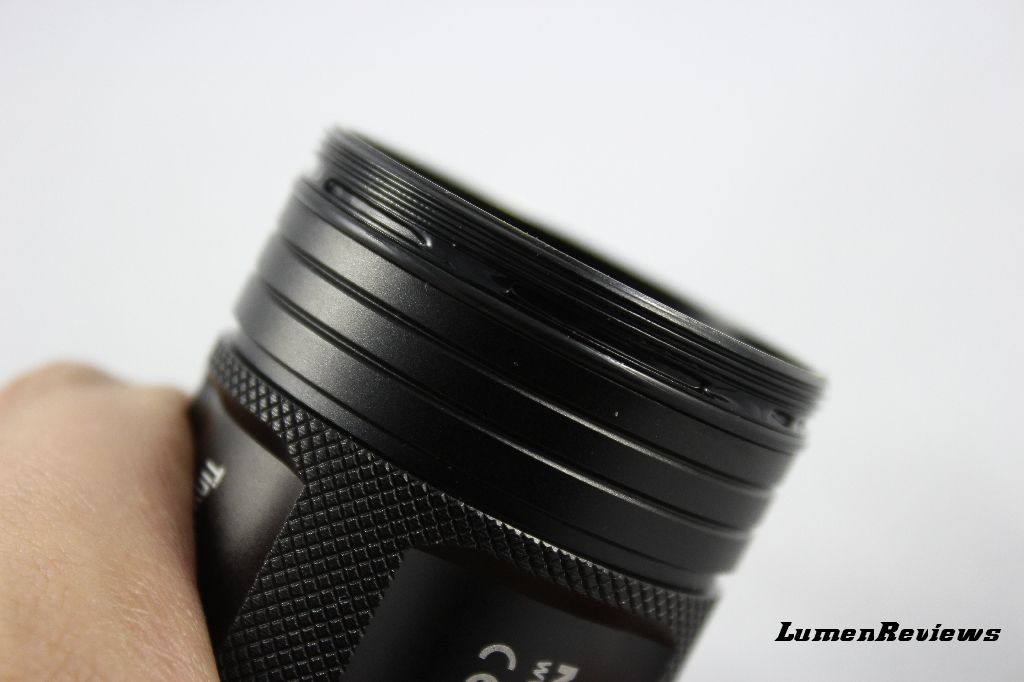
.
.
.
UI

The TM28 has two different sets of level, one that goes from 2 lumen to 2300, and another that goes from 3200 to 6000 (or 4500 if you use the light with li-ion batteries).
Some details of the OLED display
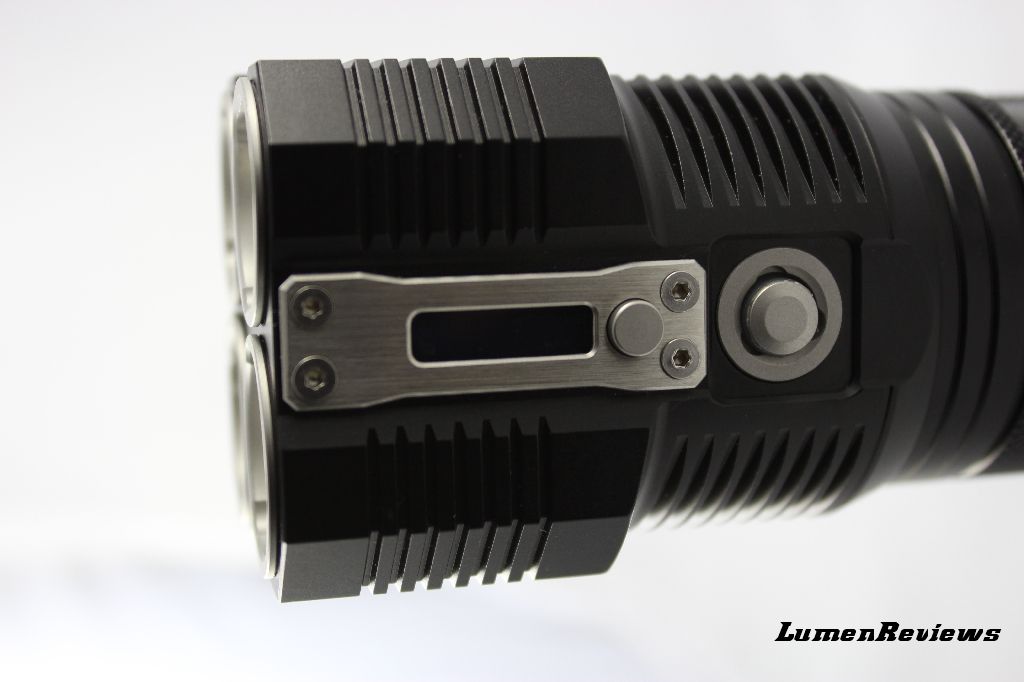
The display has two lines of text, and is backlit so it can be seen in the dark.
The first time you will see it lit is when you put batteries inside and twist the head on the body, it will turn on with NITECORE displaying, then it will ask you to choose which batteries are in the light (IMR, Li-ion, optional battery pack) scrolling through the options with the display switch, and confirming pressing the main switch.
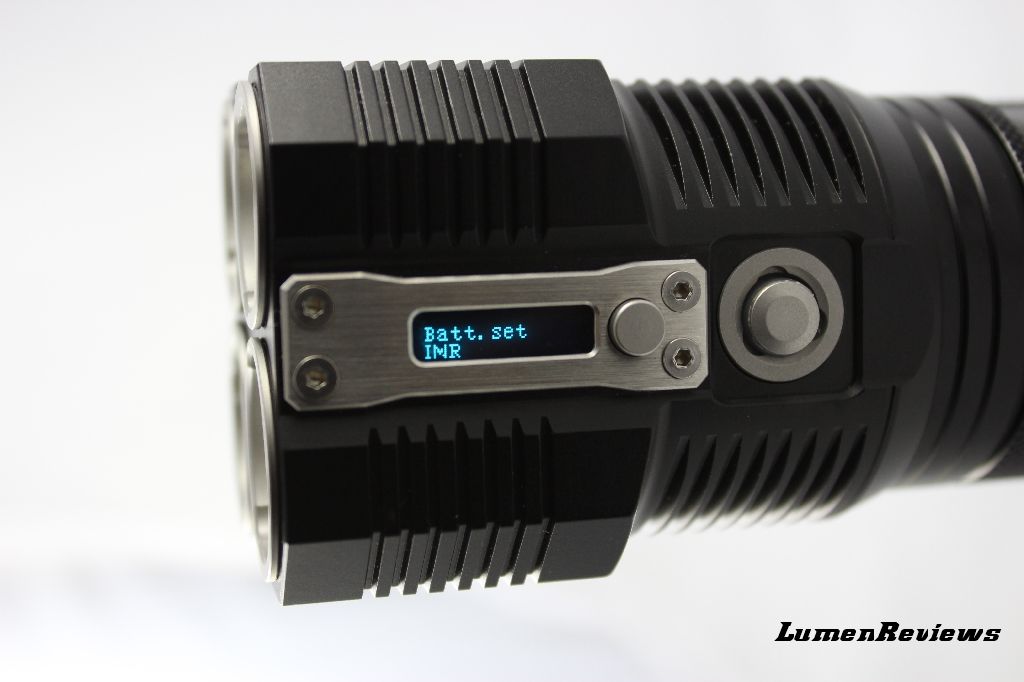
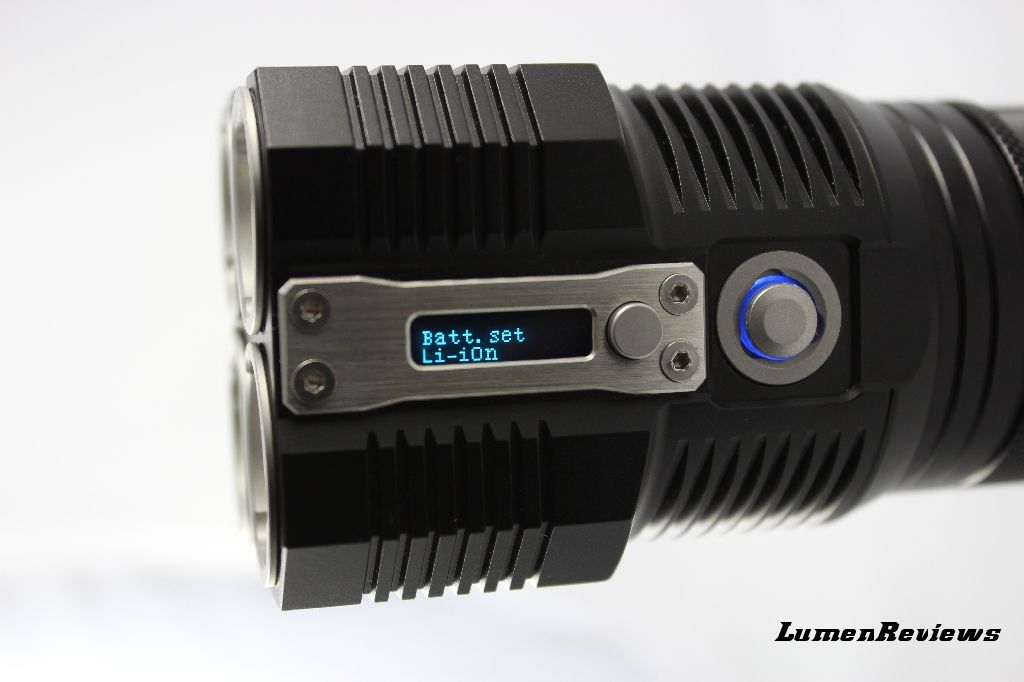

For those who wonder what battery pack we are talking, it is the NBP68HD



Confirmed the batteries, the display will say Standby and give a voltage read of the cells.
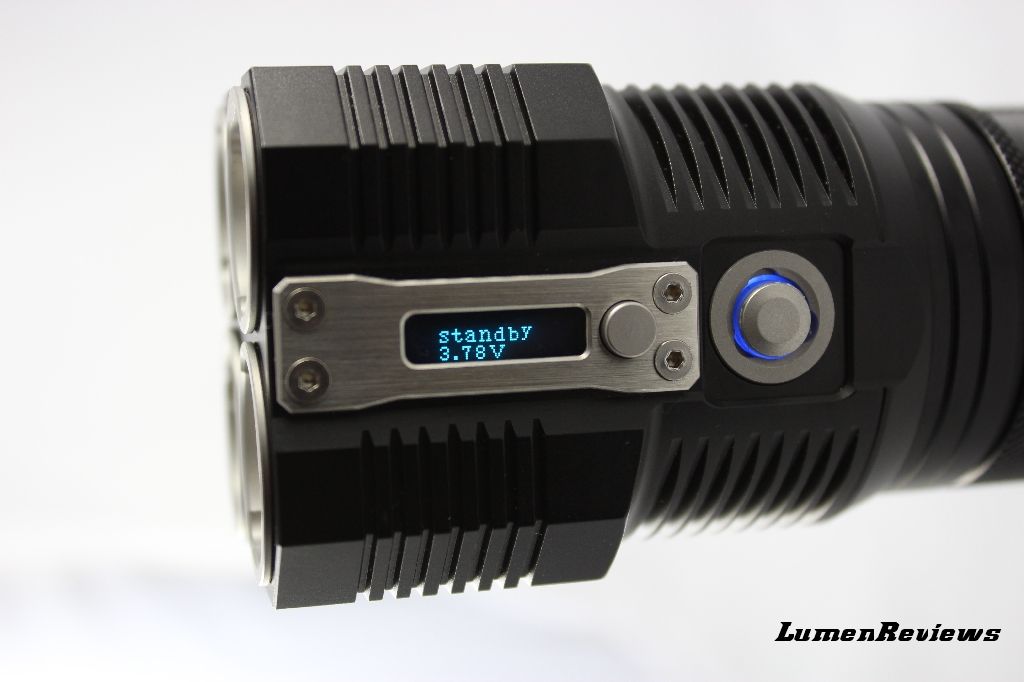
The display will turn off in a few seconds. You can press the display switch waking up the display that will still tell you the light is in standby, and give you the reading of the cells. Even when the display is off the blue LED under the switch blink as a locator. To turn the locator off you need to untwist the head from the body, physically interrupting the current flow.
When you turn the light on or change level, the display will show the following information:
Level number and spec output
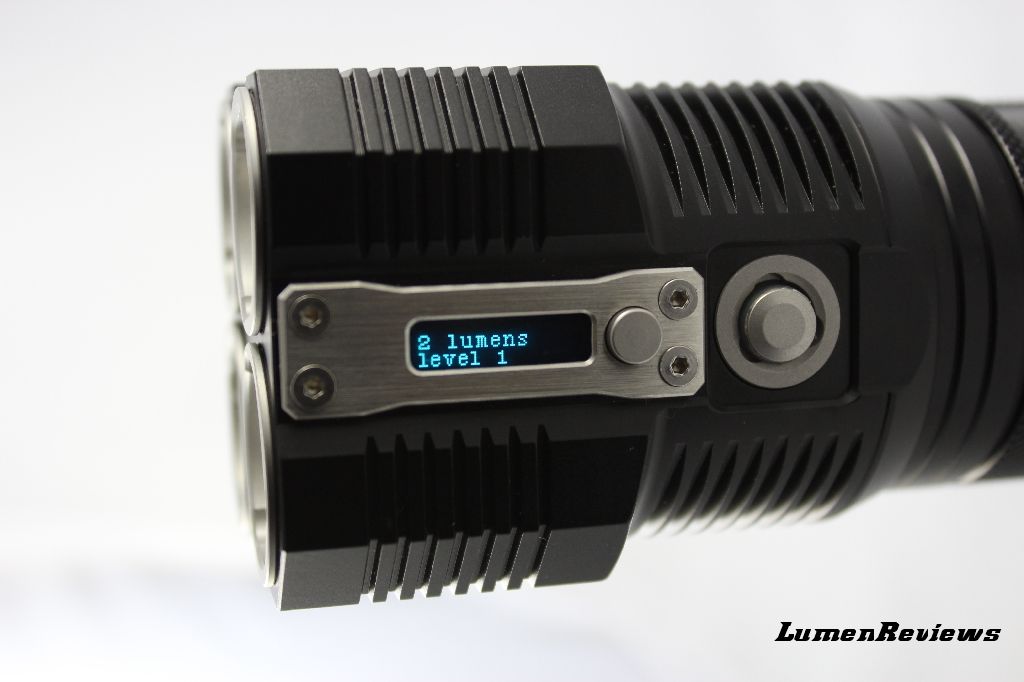
Battery voltage
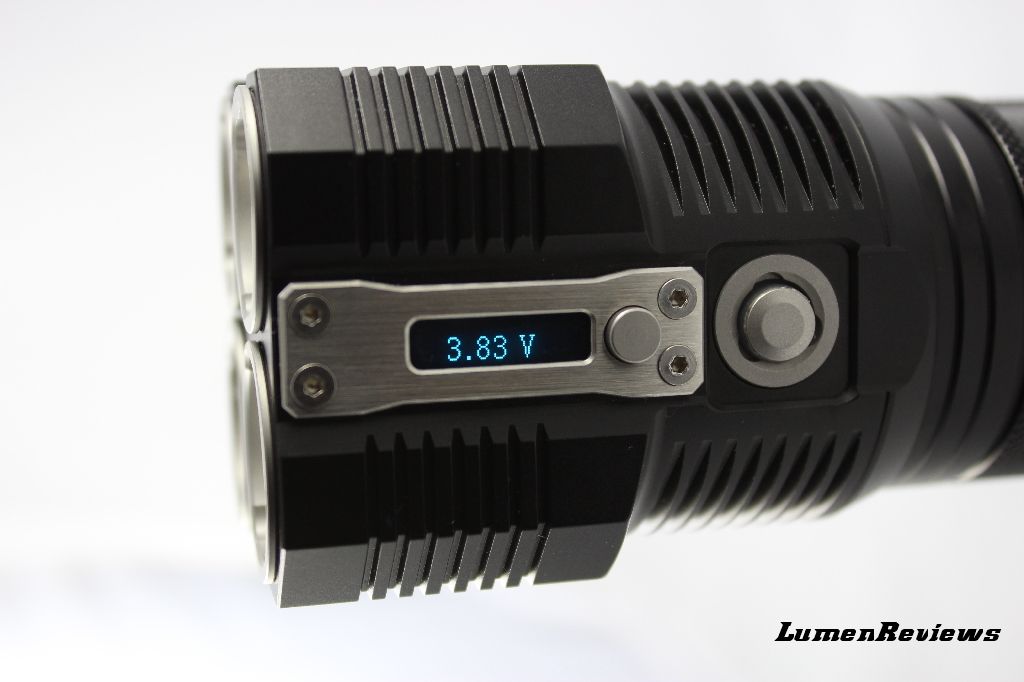
Gross battery capacity estimation
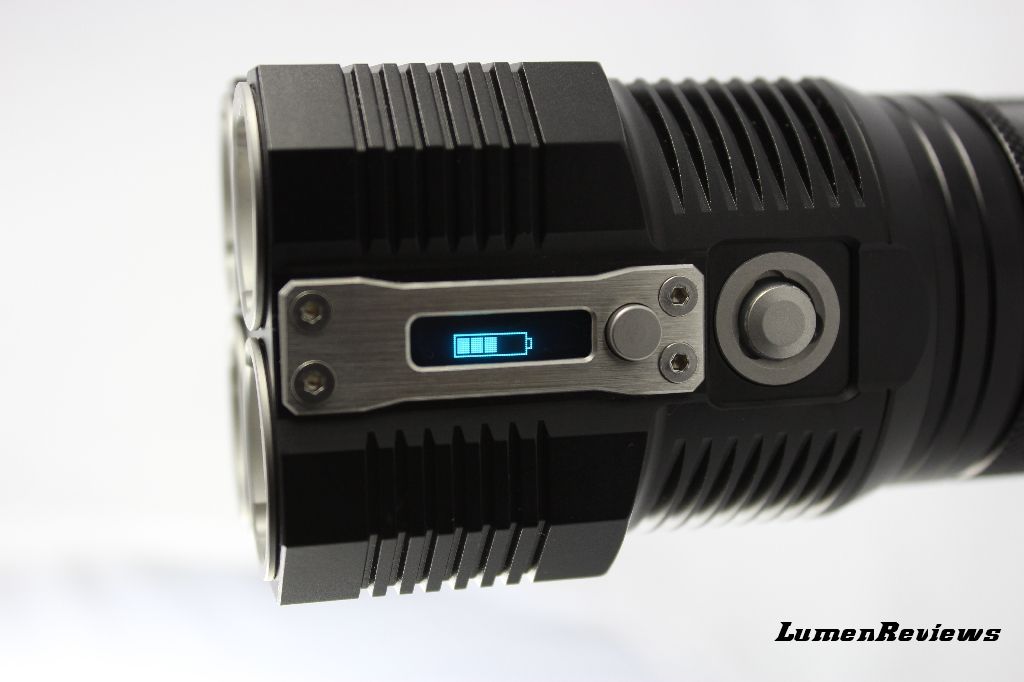
Gross runtime estimation

Internal Temperature

As you can see, the lettering have sharp and clear edges, and the info are easily deciphered.
Each information will be displayed for a bit less than 2 seconds (or you can scroll them manually pressing the display switch), and after a whole cycle (or 10 seconds), the display will turn off.
You can turn it back on at any time by pressing the display switch.
When you charge the batteries, the display will stay on and give you a read of the voltage (same when the batteries are charged). I do not have pics of that, so I will borrow one from Nitecore.

I have been told the charging current with the supplied power adapter is 2A, which divided on 4 cells, should result in 500mA per cell. The light does not work when charging; if the TM28 is on while you start the charging process the light will turn off, and turn back on when you unplug it.
On my sample while charging the batteries, I can read on the display on the last part of the charge: “Charging” and a voltage that oscillates from 4.20 to 4.25 volts. Once the charging is finished, the display reads from 4.20 to 4.22 volts. Once the batteries are charged, if I restart the charging process, the light will say “Charged” and the 4.20-4.22 volt value. Once the batteries are marked as charged, I measured their voltage, 4.18 volts.
.
.
.
Output and Runtime
Both measured with Nitecore 18650 IMR Protected 3100mAh batteries.
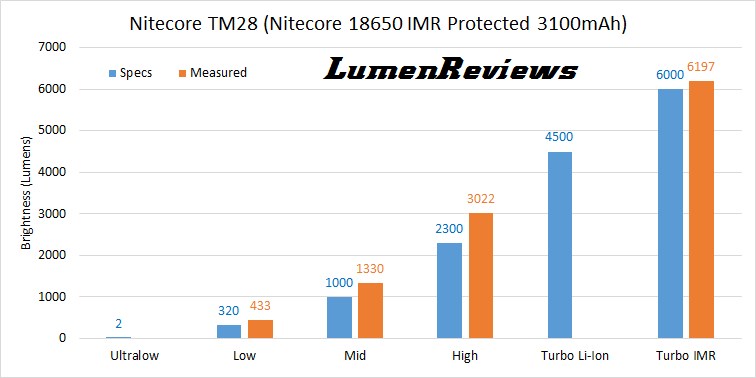
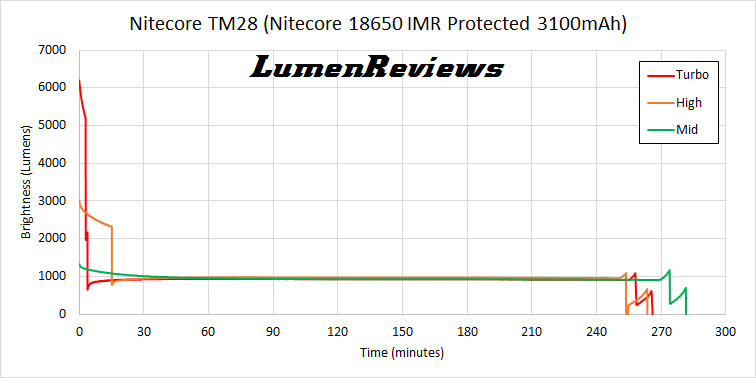
Detail

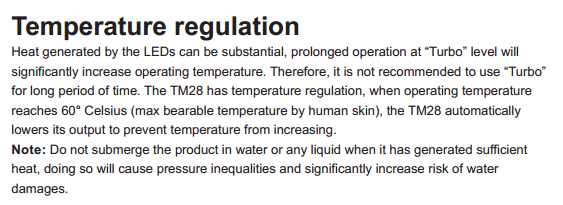
The light indeed gets quite hot but not at the point where you cannot hold it.
Let us see if a table fan can led to different charts
At turbo mode


At high mode

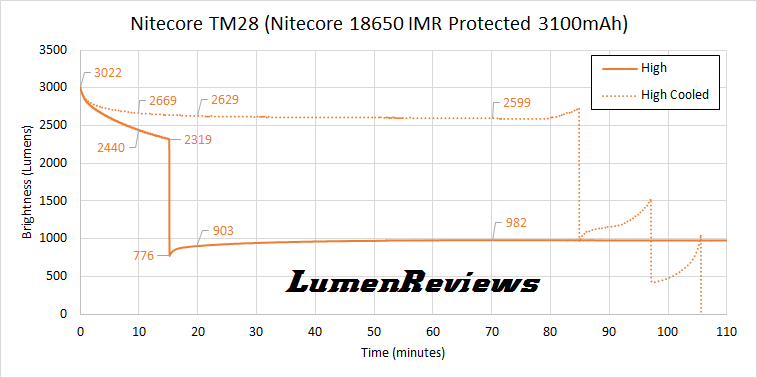
In practice, at turbo mode the light will delay the initial stepdown, and, more importantly, the light will remain at the brightness of high mode until the batteries are almost empty (whereas without ventilation the brightness of high level after the stepdown doesn’t last for long).
At high mode, the light does not stepdown and continues until the batteries are almost empty.
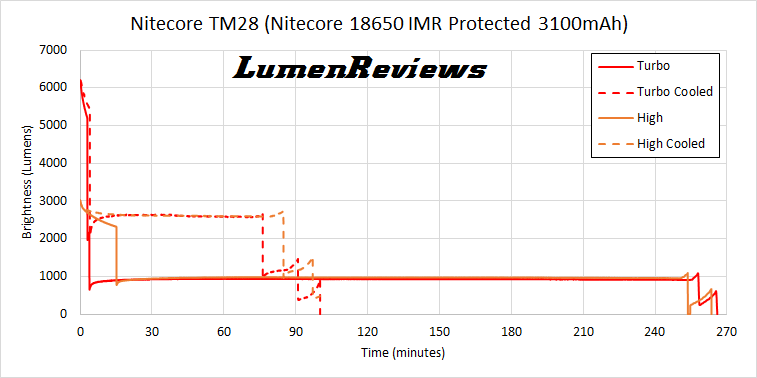

At mid mode
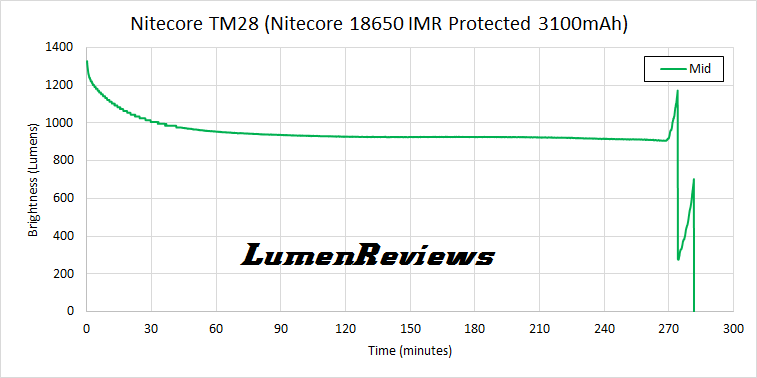
.
.
.
Beamshot, 100 meters at the threes.
Level 1 pointed to the right

Level 1 pointed forward

Level 2 pointed to the right
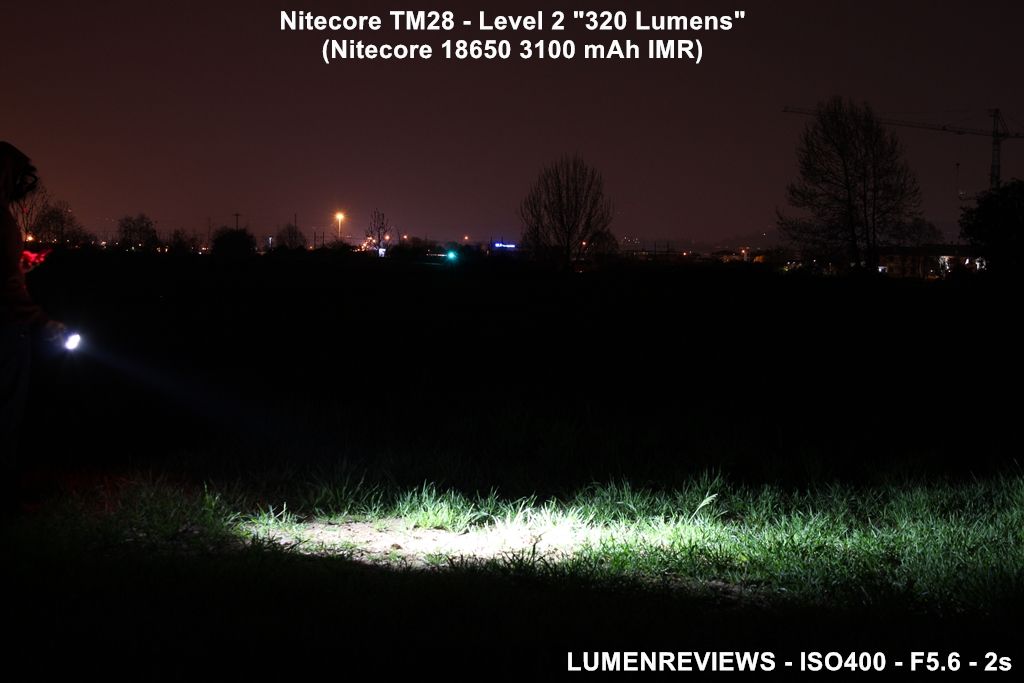
Level 2 pointed forward
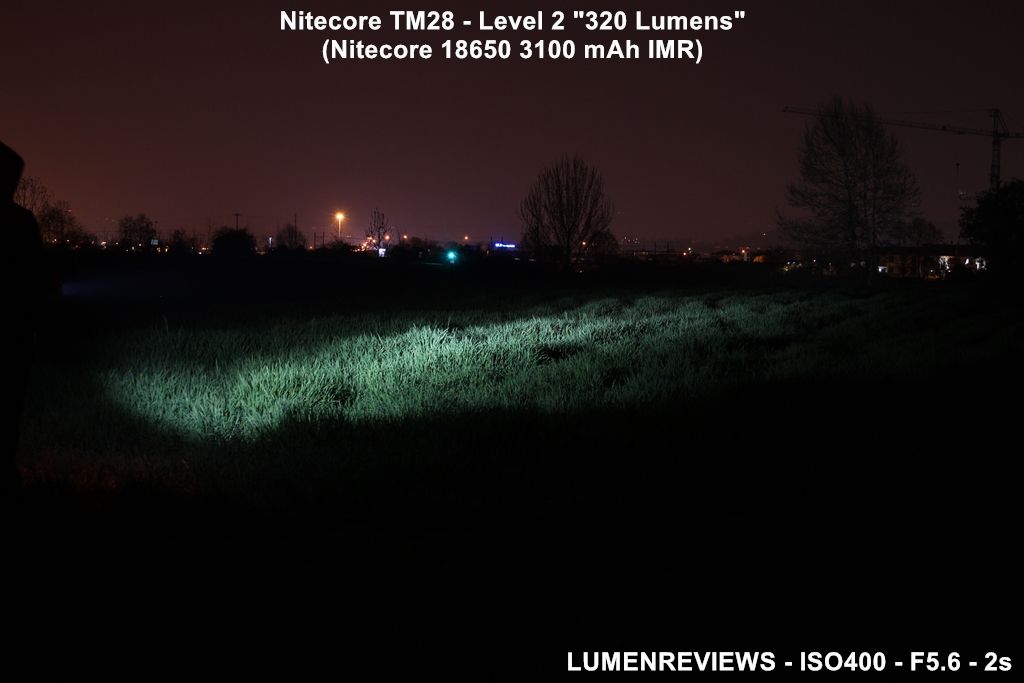
Level 3 pointed to the right

Level 3 pointed forward

Level 4 pointed forward
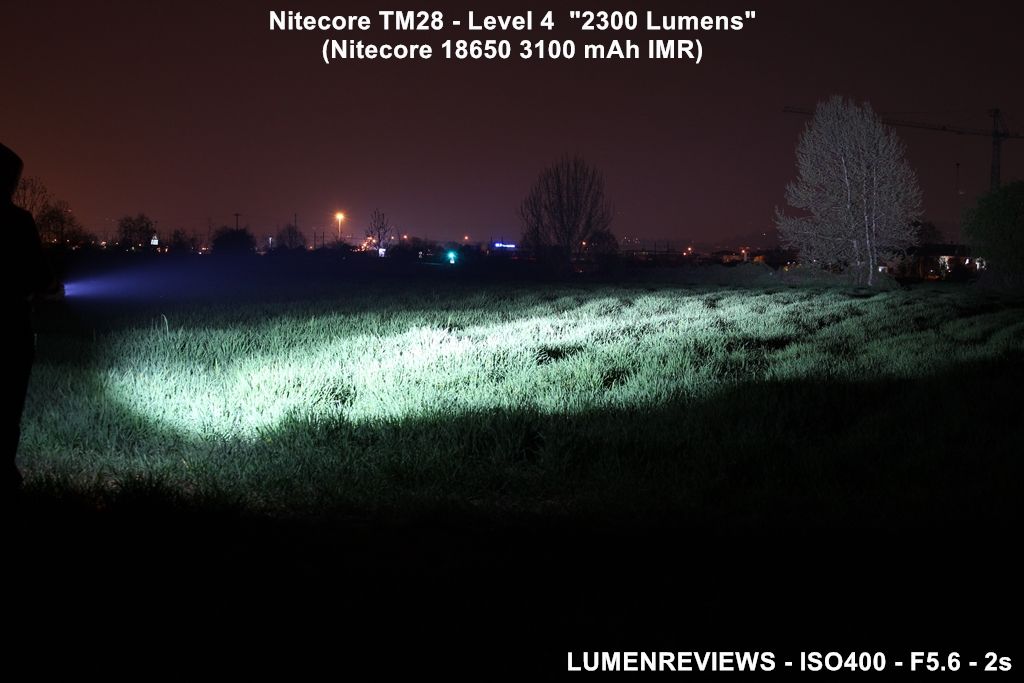
Level 5 pointed forward



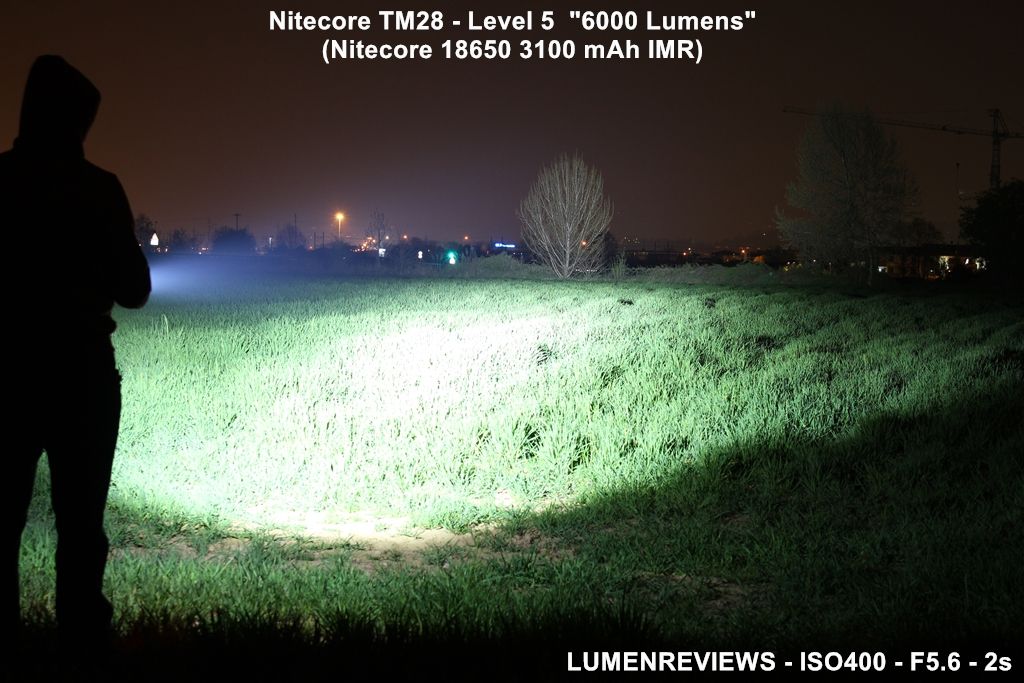
As you can see, the light offers a balance of flood and throw. The spill is wide enough to hit my shoes (means that I have fully lightened my walking plan) and even with 320 or 1000 lumens you have more than decent visibility at the distance.
In these shots, I’m on top of a wall. The other side of the wall is 167 meters from me. I do not know why in the last pic the temperature balance changed. The light does not go from cool white to warm white at turbo, for sure.
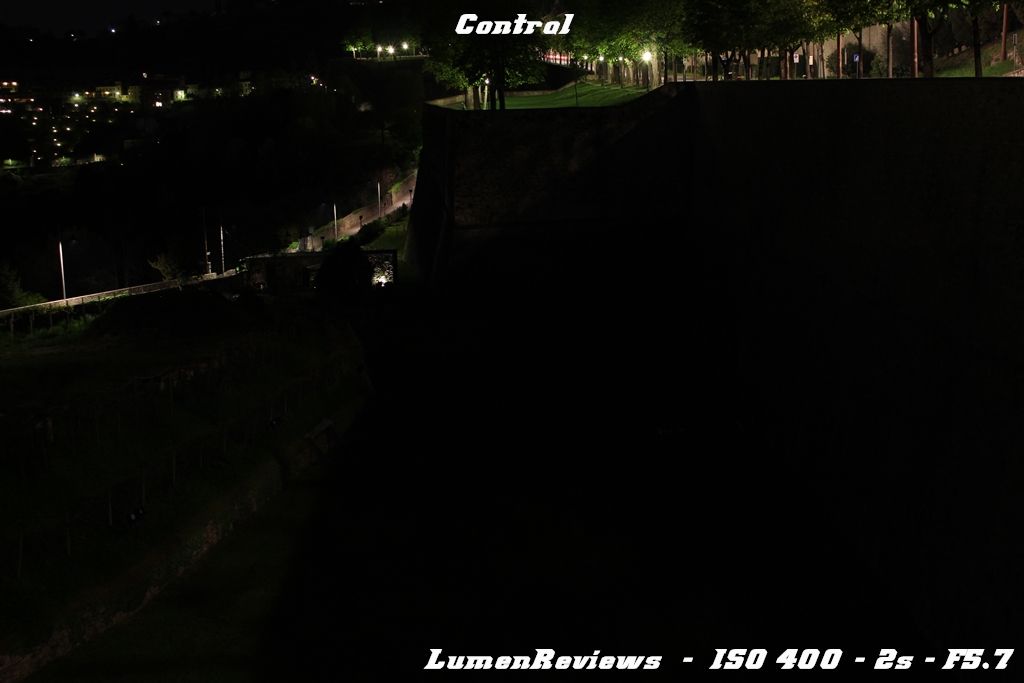
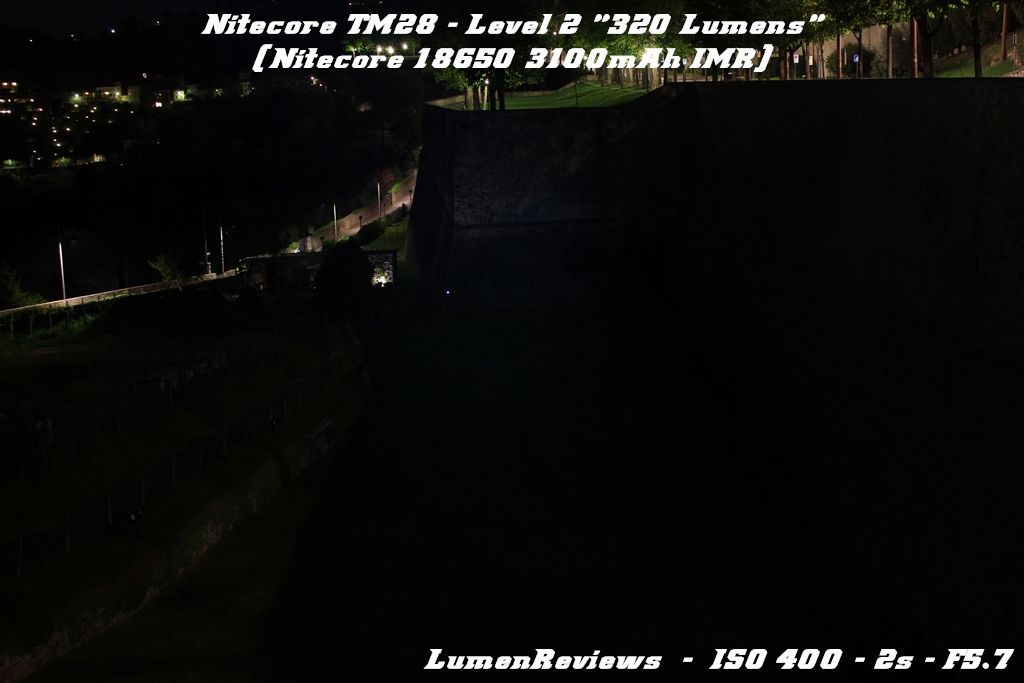

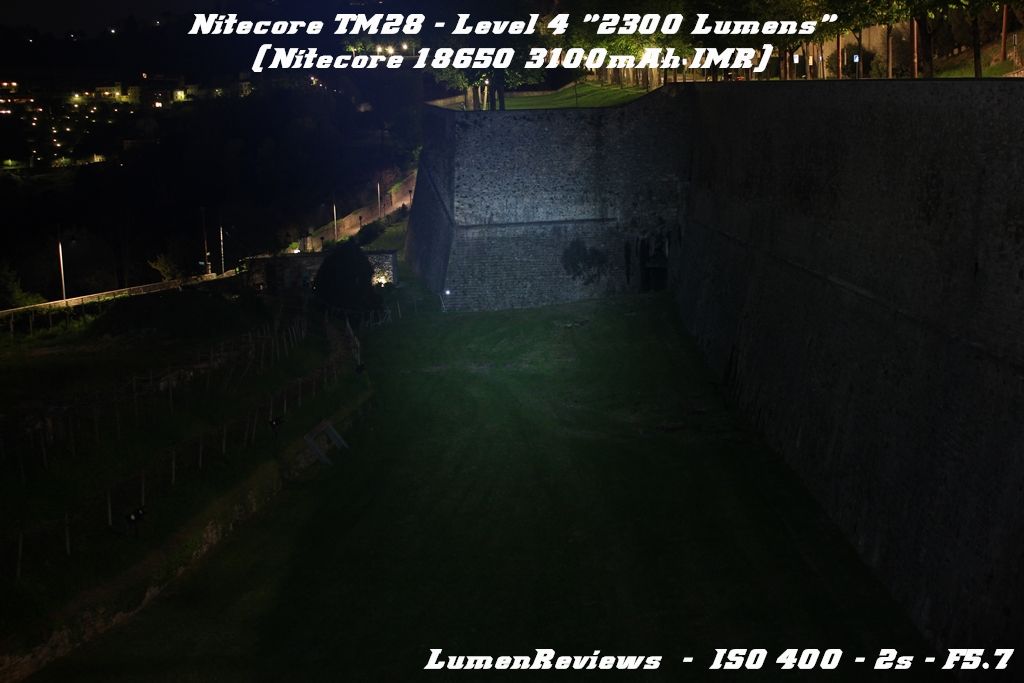
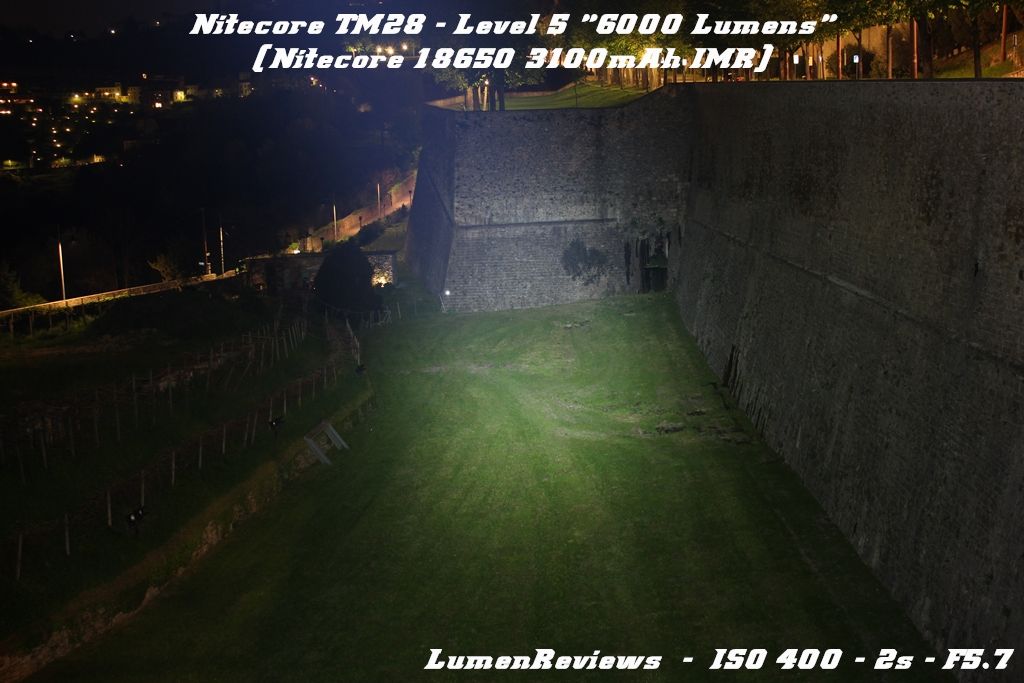
Almost doubling the distance, the TM28 still covers easily the 170meters, with a spot that now is very wide, (so it will not have a great further throw), meanwhile the spill is still very vivid and wide.
As I said, the TM28 has a balanced beam, with decent throw and an intense, wide and usable spill.
.
.
.
My thoughts
- The TM28 is well built and finished.
- The first thing I thought when I held the TM28 was “this is really smaller than I imagined”.
- The display is functional and brings a lot of information. It is also useful when the light is turned off, letting you know the voltage of the cells without needing to take the light apart or turning it on.
- I wish it could remain on for longer periods, especially on a specific information, like the temperature.
- I like the fact that the batteries are connected in parallel (which should allow a safer setup for li-ion cells, and allows in emergency to run the light with fewer batteries), and that the light features over discharge protection.
- I like that the TM28 does not have a battery carrier. To my knowledge, the TM28 is the only parallel operating, battery carrier-less light that allow you to run flat top cells (using the provided adapter).
- I find the overall 2A charging current to be on the low side, although many chargers provide 500mA per 18650 cell, almost every quality 18650 cell (traditional li-ion, IMR or hybrid) nowadays can safely be charged at 1A, cutting the charging times in half.
- The light is very well balanced in the hand, and the two switches are easy to find and hard to press the wrong one.
- I did not have issues with the double stage switch, a light tap always got me through the first set of levels, and a strong one got me to the second set.
- The tripod screw is well placed, not too much on a side of the light, so it balances well on a tripod and is easy to incline at the desired angle.
- The cordura sheath is well made, with a big sturdy metal D-ring and velcro belt over loop. it protects the light and makes easier to carry it.
- The levels are well spaced, although I would like to have another level between ultralow (two lumens), and low (320 lumens), and another one between High (2300) and Turbo (6000).
- The 2 sets of levels accessible directly allow you to set the first on a low (or low-ish) setting, and the second will always give you a high one. * I would still like to have a direct shortcut for the lowest or low mode.
- The temperature controlling system acts as advertised and the light is never hot enough to be uncomfortable to hold.
- If someone asks “what is the use of a display on a light”? The answer is answered above: it is an extra feature that provides a lot of information, contributes to the look of the light and helps justifying the high-end price you pay for this light.
- I would like to see the light come with NW tint and a car 12V adapter to charge the light in the car.
- I would be happier if the TM28 had a micro USB charging port for charging the light, without requiring a proprietary adaptor (although the rubber cover goes deeply inside the port and is not pulled off without a certain effort, definitely more than any other micro USB port cover I tried so far).
Thanks to AntoLed for the luxmeter and the camera advices